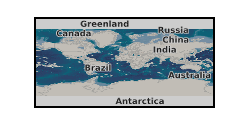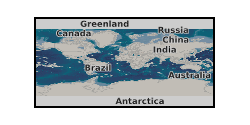Phosphates
Type of resources
Available actions
Topics
Keywords
Contact for the resource
Provided by
Years
Formats
Update frequencies
-

The data include measurements of adsorption experiments, where the adsorption fraction of phosphite and phosphate on experimentally-prepared ferric iron oxides were measured. The amounts of phosphate and phosphate as well as iron retained in solution were measured to calculate the fractions adsorbed relative to iron precipitated. In addition, total phorphorus and iron concentrations as well as phosphite and phosphate concentrations in leachates of natural banded iron formation samples from the Neoarchean to Paleoproterozoic. For the BIF samples, also XRD data are presented.
-

Organic carbon and total nitrogen isotope data for black shales and U-Pb data for apatite solutes from the Burzyan and Yurmatau groups in the Urals, Russia. For detailed discussion see Stüeken, E.E., Kuznetsov, A.B., Vasilyeva, I.M., Krupenin, M.T. and Bekker, A., 2021. Transient deep-water oxygenation recorded by rare Mesoproterozoic phosphorites, South Urals. Precambrian Research, 360, p.106242.
-

The data include total phosphorus abundances and concentrations of oxidized (phosphate) and reduced phosphorus (phosphite) for a series of samples spanning the S2 meteorite impact event recorded in the Barberton Greenstone Belt in South Africa at 3.2 billion years ago. The data explore the effects of impacts and hydrothermal silicification on the phosphorus redox cycle in the Archean.
-

U-Pb isotope ratio data set for numerous phosphate (apatite) grains in two thin section samples of the LL5 S4-6 Chelyabinsk meteorite. One section is of the S4-6 light lithology, and another of the S5-6 dark lithology. Samples analysed were section ‘A' (light lithology) and section ‘B’ (dark lithology) of Chelyabinsk, both from the Open University School of Physical Sciences sample collection. The results demonstrate variability in degree of Pb-loss during collisional reheating from pristine versus damaged apatite crystal domains. These results are reported for a meteorite fall which originally happened near Chelyabinsk in Russia. The results otherwise have no geographic location, as this is a sample of an asteroid. All measurements were made in December 2020. These data were collected using Secondary Ionisation Mass Spectrometry (SIMS) with a CAMECA IMS 1280 at the Institute of Geology and Geophysics, Chinese Academy of Sciences (IGGCAS). The thin sections were polished with colloidal silica, cleaned, and coated with gold prior to analysis. Microtextural information was obtained prior to analysis using a combination of back-scatter-electron, cathodoluminescence, and electron-back-scatter-diffraction analysis. Data were obtained to test hypotheses relating to the competition between macro-to-meso-scale thermally-driven variation in Pb-loss rates versus microscale variation driven by grain-specific features, e.g., fracture networks. An article describing and discussing these results, including further methodological steps in their collection and processing, is due for publication. This information is currently available in preprint form on arXiv: https://arxiv.org/abs/2112.06038
 NERC Data Catalogue Service
NERC Data Catalogue Service